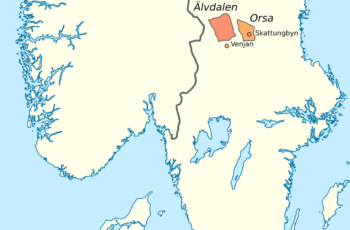
Map of Scandinavian regions with vowel nasality.
by u/Coedwig
Vowel nasality existed in Old Norse, both with adjacent nasal consonants, but also with nasal consonants that were lost, but present in Proto-Norse or Proto-Germanic, (such as gás < PGmc *gans ’goose’). This map shows the regions of Scandinavia that are traditionally described as having nasal vowels.
The orange areas have secondary vowel nasality, i.e. where a nasal consonant existed in Old Norse (e.g. Selbu hõ (<ON hon ’she’). The red areas also have secondary vowel nasality, but have also inherited the Old Norse vowel nasality, such as Elfdalian gą̊s.
Some important villages are marked on the map: Vikvarvet, which has preserved the nasal vowels the most in Selbu; Skattungbyn, which has primary vowel nasality as well as a wider range of nasal vowels; as well as Venjan in Mora which is the only village in its municipality to have nasal vowels.
Today, nasal vowels have disappeared in Venjan and probably in Orsa, but is preserved in Älvdalen and perhaps among older people in Selbu.
Sources:
- Boëthius, Johannes (1918). Orsamålet. 1, Ljudlära. Diss. Uppsala : univ.
- Haugen, Einar (ed.) (1950). ”First grammatical treatise: The earliest Germanic phonology” Language, Vol. 26, No. 4, Language Monograph No. 25.
- Noreen, Adolf (1886). ”De nordiska språkens nasalerade vokaler”.
Arkiv för nordisk filologi. III, pp. 1–41. - Røset, Ingulv (2011). Selbumålet. Novus.
- Steensland, Lars (2011). ”Parasitisk (oetymologisk) nasalisering i älvdalskan” Oðer råðstemną um övdalskų. pp. 116–126
- Åkerberg, Bengt (2012). Älvdalsk grammatik, Mora: Ulum dalska
